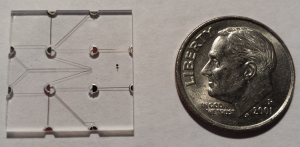
Speaker: Weihua Guan, Ph.D.
Assistant Professor
Department of Electrical Engineering & Department of Biomedical Engineering (courtesy)
Pennsylvania State University, University Park
Date: Thursday, April 8, 2021
Time: 3:00-4:00 PM EDT
Zoom – check email for link or contact ksas@seas.upenn.edu
Abstract:
Due to their conceptual simplicity, the nanopore sensors have attracted intense research interest in electronic single molecule detection. While considerable success has been achieved, the solid-state nanopores still face three significant challenges, including repeatable nanopore size control, introduction sensing specificity, and prolonged sensor response time at low concentrations. In this talk, I will discuss a calibration-free solid-state nanopore counting method and two representative applications in nucleic acid testing. One is an isothermal amplification-coupled nanopore counting for malaria analysis. The other is the CRISPR-cas12a-coupled nanopore counting for HIV analysis. Finally, I will also discuss how we can develop a fully integrated ‘sample-to-result’ nucleic acid testing device using the solid-state counting strategy. I believe the reaction-coupled solid-state nanopore digital counting could open a new avenue towards compact, robust, low-cost electronic nucleic acid testing at the point of care.
Weihua Guan Bio:
Weihua Guan received his Ph.D. degree in Electrical Engineering from Yale University in 2013 and did his postdoctoral training at Johns Hopkins University from 2013 to 2014. He joined the Department of Electrical Engineering at Pennsylvania State University in Jan 2015. He also held a courtesy appointment in the Department of Biomedical Engineering at Penn State. Dr. Guan’s research interests are in the multidisciplinary areas of micro- and nanotechnology, micro/nanofluidics, bioMEMS, lab-on-a-chip devices, and point-of-care devices. Dr. Guan’s research group at Penn State focuses on developing micro and nanoscale devices as well as novel sensing principles towards advanced medical diagnostics and testing. Dr. Guan is a member of IEEE, Engineering in Medicine and Biology Society, Biophysical Society, and American Physics Society. Among other honors, Dr. Guan is a recipient of the HHMI International Research Fellowship and NSF CAREER award.


 In the last 20 years, microfabrication techniques have allowed researchers to miniaturize tools for a plethora of bioanalytical applications. In addition to better sensitivity, accuracy and precision, scaling down the size of bioanalytical tools has led to the exploitation of new technologies to further manipulate biomolecules in ways that has never before been achieved. For example, when microfluidic channels are on the same order of magnitude of the electric double layers that form due to localized charge at the surfaces, there exists unique physics that create different flow phenomenon, such as analyte concentration and/or separation, mainly due to the couples physics of electrostatics and fluid dynamics. This talk will outline the basis of such interesting phenomena, such as nanofluidic separation and concentration, and well as probe the applications of such coupled systems, for example, handheld DNA detection. Most importantly, we will focus on the most recent work in the Pennathur lab in this field — biopolar electrode (BPE)-based phenomenon. Bipolar electrodes (BPE) have been studied in microfluidic systems over the past few decades, and through rigorous experimentally-validated modeling of the rich combined physics of fluid dynamics, electrokinetics, and electrochemistry at BPEs, I will show the potential of utilizing microfluidic-based BPEs for the design and development of low power, accurate, low volume fluid pumping mechanisms, with the ultimate goal of integration into wearable drug delivery and µTAS systems.
In the last 20 years, microfabrication techniques have allowed researchers to miniaturize tools for a plethora of bioanalytical applications. In addition to better sensitivity, accuracy and precision, scaling down the size of bioanalytical tools has led to the exploitation of new technologies to further manipulate biomolecules in ways that has never before been achieved. For example, when microfluidic channels are on the same order of magnitude of the electric double layers that form due to localized charge at the surfaces, there exists unique physics that create different flow phenomenon, such as analyte concentration and/or separation, mainly due to the couples physics of electrostatics and fluid dynamics. This talk will outline the basis of such interesting phenomena, such as nanofluidic separation and concentration, and well as probe the applications of such coupled systems, for example, handheld DNA detection. Most importantly, we will focus on the most recent work in the Pennathur lab in this field — biopolar electrode (BPE)-based phenomenon. Bipolar electrodes (BPE) have been studied in microfluidic systems over the past few decades, and through rigorous experimentally-validated modeling of the rich combined physics of fluid dynamics, electrokinetics, and electrochemistry at BPEs, I will show the potential of utilizing microfluidic-based BPEs for the design and development of low power, accurate, low volume fluid pumping mechanisms, with the ultimate goal of integration into wearable drug delivery and µTAS systems.